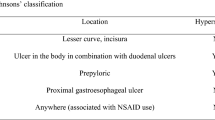Abstract
Background
The place of laparoscopic repair of perforated peptic ulcer followed by peritoneal toilet has been established, although it is not routinely practiced. This prospective study compared laparoscopic and open repair of perforated peptic ulcer disease. We evaluated whether the early results from laparoscopic repair resulted in improved patient outcome compared with conventional open repair.
Methods
All patients who underwent repair of perforated peptic ulcer disease during a 12-month period in our unit were included in the study. The primary end points that were evaluated were total operative time, nasogastric tube utilisation, intravenous fluid requirement, total time of urinary catheter and abdominal drainage usage, time taken to return to normal diet, intravenous/intramuscular opiate use, time to full mobilization, and total in-patient hospital stay.
Results
Thirty-three patients underwent surgical repair of perforated peptic ulcer disease (19 laparoscopic repairs and 14 open repairs; mean age, 54.2 (range, 32–82) years). There was no increase in total operative time in patients who had undergone laparoscopic repair (mean: 61 minutes laparoscopic versus 57 minutes open). There was significantly less requirement for intravenous/intramuscular opiate analgesia in patients who had undergone laparoscopic repair (mean time to oral analgesia: 1.2 days laparoscopic versus 3.8 days open). In addition there was a significant decrease in the time that the nasogastric tube (mean: 2.1 days laparoscopic versus 3.1 days open), urinary catheter (mean: 2.3 days laparoscopic versus 3.7 days open) and abdominal drain (mean: 2.2 days laparoscopic versus 3.8 days open) were required during the postoperative period. Patients who had undergone laparoscopic repair required less intravenous fluids (mean: 1.4 days laparoscopic versus 3.1 days open) and returned to normal diet (mean: 2.3 days laparoscopic versus 4.8 days open) and full mobilization significantly earlier than those who had undergone open repair (mean: 2.3 days laparoscopic versus 3.3 days open). In addition, patients who had undergone laparoscopic repair required a shorter in-patient hospital stay (mean: 3.1 days laparoscopic versus 4.3 days open).
Conclusions
Laparoscopic repair is a viable and safe surgical option for patients with perforated peptic ulcer disease and should be considered for all patients, providing that the necessary expertise is available.

Similar content being viewed by others
References
Koo J, Ngan Lavn SK (1983) Trends in hospital admissions, perforation and mortality of perforation and mortality of peptic ulcer in Hong Kong from 1970–1980. Gastroenterology 84:1558–1562
Alagarantnam TT, Wong J (1988) No increase in duodenal ulcer surgery after cimentidine in Hong Kong. J Clin Gastroenterol 10:25–27
Ganshefski L, Flancbaum L, Brolin RE et al (1990) Changing patterns in perforated peptic ulcer disease. Ann Surg 56:270–274
Graham DY (1993) Treatment of peptic ulcers caused by Helicobacter pylori. N Engl J Med 328:349–350
NIH consensus development panel (1994) Helicobacter pylori in peptic ulcer. JAMA 272:65–69
Sung JJ, Chung SC, Ling TK (1995) Antibacterial treatment of gastric ulcer associated with Helicobacter pylori. N Engl J Med 332:139–142
Croft TJ, Park KGM, Steele RJC et al (1989) A randomized trial of non-operative treatment of perforated peptic ulcer. N Engl J Med 320:970–973
Sawyer JL (1992) Acute perforations of peptic ulcer. In: Scott HW, Sawyers JL (eds) Surgery of the stomach, duodenum and small intestine, 2nd edn. Blackwell Scientific, Boston, pp 56–572
Hugh TB (1990) Perforated peptic ulcers. In: Schwarz S, Ellis HA (eds) Maringot’s abdominal operations, 9th edn. Appleton and Lange, Norwalk, CT, pp 627–645
Nathanson LK, Easter DW, Cuschieri A (1990) Laparoscopic repair/peritoneal toilet of perforated duodenal ulcer. Surg Endosc 4:232–233
Perrissat J, Collet D, Edge M (1992) Therapeutic laparoscopy. Endoscopy 24:138–143
Mouret P, Francois Y, Vaginal J (1990) Laparoscopic treatment of perforated peptic ulcer. Br J Surg 77:1006
Beriot J, Champault GG, Labhar E et al (1992) Sutureless laparoscopic treatment of perforated duodenal ulcer. Br J Surg 80:1212
Lau WY, Leung KL et al (1995) Laparoscopic repair of perforated peptic ulcer. Br J Surg 82:814–816
Lau WY, Leung KL, Kwang KH et al (1996) A randomized study comparing laparoscopic versus open repair of perforated peptic ulcer using suture or sutureless technique. Ann Surg 224:131–138
Siu WT, Leong HT, Law BKB (2002) Laparoscopic repair for perforated peptic ulcer a randomized controlled trial. Ann Surg 235:313–314
The Southern Surgeon Club (1991) A prospective analysis of 1518 laparoscopic cholecystectomy. N Engl J Med 324:1073–1078
Naegaard JM, Edwin B, Reiertsen O (1999) Laparoscopic and open operations in patients with perforated peptic ulcer. Eur J Surg 165:209–214
Katkhouda N, Maver E, Mason R (1999) Laparoscopic repair of perforated duodenal ulcers. Outcome and efficacy in 30 consecutive patients. Arch Surg 134:845–850
Tate TTJ, Dawson JW, Lau WY et al (1993) Sutureless laparoscopic treatment of perforated duodenal ulcer. Br J Surg 80:235
Sumbria AE, Morales CH, Villegas M (2005) Laparoscopic repair for perforated peptic ulcer disease. Cochrane Database Syst Rev 4:CD004778
Lunevicius R, Morkevicius M (2005) Comparison of laparoscopic versus open repair for perforated duodenal ulcers. Surg Endosc 19:1565–1571
Kirshtein B, Byrne M, Mayer T et al (2005) Laparoscopic treatment of gastroduodenal perforations: comparison with conventional surgery. Surg Endosc 19:1487–1490
Acknowledgments
The authors thank Professor Nigel Stallard of Warwick University for his help with the statistical analysis.
Author information
Authors and Affiliations
Corresponding author
Rights and permissions
About this article
Cite this article
Bhogal, R.H., Athwal, R., Durkin, D. et al. Comparison Between Open and Laparoscopic Repair of Perforated Peptic Ulcer Disease. World J Surg 32, 2371–2374 (2008). https://doi.org/10.1007/s00268-008-9707-5
Published:
Issue Date:
DOI: https://doi.org/10.1007/s00268-008-9707-5



